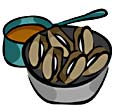|
 N N
Napoleon:
This light pastry filled with rich cream, which is also known as mille foglie (many leaves) in Italy, most likely originated in Naples. The French term, à la Napolitaine may have garbled in translation. No one can say for sure. The little emperor would have enjoyed it though, judging from his rather stocky stature. The Danish have laid claim to this pastry, stating unequivocally that it was invented after a visit to Denmark by Napoleon.

Lord Nelson Apple:
This apple gets its namesake from Admiral Horatio Nelson (1758-1805), the British hero of the Battle of Trafalgar. The admiral also had a dish of mutton cutlets named after him as well as a boiled sweet hard candy known in circles not so delicate as "Nelson’s Balls".
 Lobster Newberg: Lobster Newberg:
Spelled either Newburg or Newburgh, this dish is today applied to other seafood besides lobster. As the story goes, this creation is attributed to Captain Ben Wenberg, who brought this recipe, which he discovered in his many travels to Charles Ranhofer, the chef at Delmonico’s in the late 19th century. Ranhofer reproduced the dish and put it on the restaurant menu as "Lobster Wenberg." Allegedly, the two men fell out of favor and Ranhofer removed the dish from the menu, but it was so popular among customers that he brought it back and changed the name to Newberg.
O
Veal Orloff:
Count Gregory Orloff, paramour of Catherine The Great, is often cited as the source of this dish but it more likely comes from noted 19th century chef, Urbain Dubois, who is said to have created it for his veal-hating employer, Prince Nicolas Orloff, minister to Tsar Nicolas I. That would explain the multiple sauces and seasoning inherent in the dish.
Veal Oscar:
This dish is attributed to Sweden’s King Oscar II (1829-1907) who was very fond of this combination of veal, white asparagus, lobster and béarnaise sauce. Sometimes this dish is made with chicken or crab.
P
Dr. Pepper Soft Drink:
Charles Atherton, a pharmacist, invented this soft drink in 1885. According to legend, it was born in a Waco, Texas, drug store owned by Wade Morrison and named after Morrison’s first employer who owned a pharmacy in Virginia.
Dom Pérignon:
This fine wine gets its name from Pierre Dom Pérignon, a blind, French Benedictine monk (1638-1715) who was an expert wine maker. He is credited with having developed this first true champagne in the late 17th century when there wasn’t much else for a blind monk to do for fun.
 R R
Reuben Sandwich:
This sandwich has two possible origins. One legend claims it dates back to 1914 and was named after New York restaurant owner, Arnold Reuben (1883-1970). Still another tale claims the creator was one Reuben Kolakofsky (1874-1960) who is said to have invented the sandwich to serve for his "poker group" which gathered at his Omaha, Nebraska, grocery.
 Oysters Rockefeller: Oysters Rockefeller:
This dish was first made for John D. Rockefeller by the son of Antoine Alciatore in New Orleans at Antoine’s restaurant. The original recipe remains a secret, but the mixed greens were not the spinach that now characterizes most versions of this dish.

Baby Ruth:
There are two versions concerning the origins of this famous candy bar but the former is by far the most likely to have occurred. One source claims that baseball hero, Babe Ruth, was the inspiration behind the name. From the very beginning, the developer of the bar, the Curtiss Candy Company, insisted that the candy bar was named after a daughter of President Grover Cleveland (Ruth Cleveland) who died in 1904 at the age of 12. It’s a moot point, however, as the candy bar was first introduced to the public in 1921 just when George Herman Ruth was at the apex of his baseball career. In all probability, Babe Ruth is the source, as not only did the early versions of the bar wrapper offer a baseball glove for 79 cents, the Babe himself announced his intent to sue the company for using his name without permission.
S
Salisbury Steak:
Dr. James Salisbury (1823-1905) was an early advocate of health food and he had that in mind when he created this dish of steak and onions and advised his patients to eat it three times a day, while limiting their intake of "poisonous" vegetables and starches. (It is not known how many arteries clogged in the process of this regimen and the issue must remain a moot and very clogged high cholesterol point to this day.)
The Sandwich:
Meat between slices of bread has been eaten since the dawn of time but there is no question that the 4th Earl of Sandwich, John Montagu (1718-1792) popularized the idea among English gambling royalty. His name was applied to the concoction circa 1762, when in a desire to not interrupt a card game by the summoning the forks, he began serving this type of food at his gambling tables. (It is not known how much he won or lost, or if he had a lucky meat and bread type as well as lucky and unlucky numbers!)
Crepes Suzette:
Said to have originated in Monte Carlo at the Café de Paris in January of 1896, this special dessert was served to the then Prince of Wales, Edward VII. According to legend, Henry Charpentier, the chef, produced this flaming crepe dish on the spot when the prince ordered a "special dessert" for himself and a female dining companion. Reportedly, Edward asked the chef to name the dish after his companion rather than himself.

T
Shirley Temple:
This drink named after child star, Shirley Temple, was created by Chasen’s Hollywood restaurant in the late 1930s. Its ingredients include: club soda, grenadine and a maraschino cherry. A slice of orange and a straw is suggested, but the paper parasol is definitely optional.
Chicken Tetrazzini:
Luisa Tetrazzini, operatic soprano also known as the "Florentine Nightingale," is the source of this chicken dish, which was created circa the late 1930s in San Francisco.
Tootsie Roll:
Clara "Tootsie" Hirschfield, the small daughter of Leo Hirschfield, developer of the first paper-wrapped penny candy in New York in 1896, is the source of this candy’s name.
W
Beef Wellington:
The personal chef of Arthur Wellesley, the First Duke of Wellington and British hero of the Battle of Waterloo is most likely the originator of this beef dish with pâté, mushrooms, truffles and Madeira sauce encased in a pastry sauce. Legends vary, but some say the shape of the dish resembles the famous Wellington boot.
And so my friends, we have reached the end of the alphabet, which can also be translated into meaning that this is the end of this rather impromptu chronicle. The next time you bite into a Reuben sandwich or sip on a Margarita, think of the people these foods and drinks were named after and smile. (After all, they are dead and you are the one enjoying the food!)
Happy Alphabet!
Did you know . . .
|